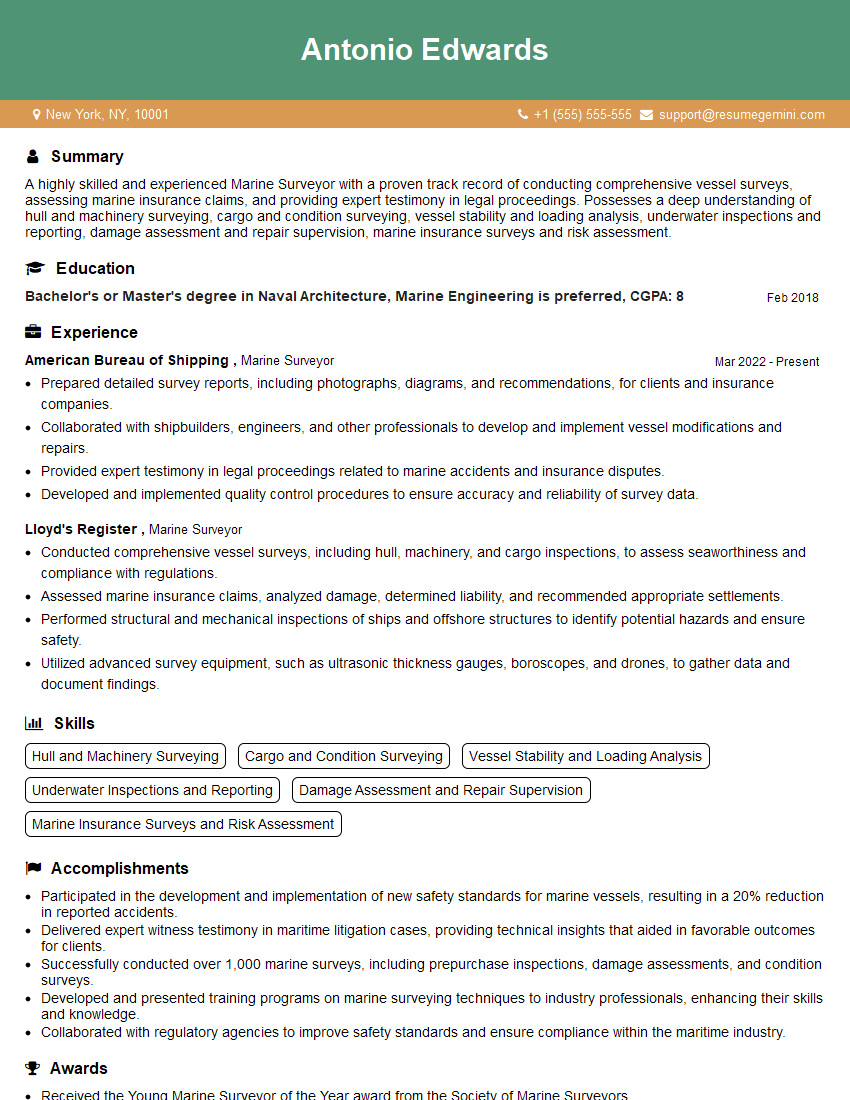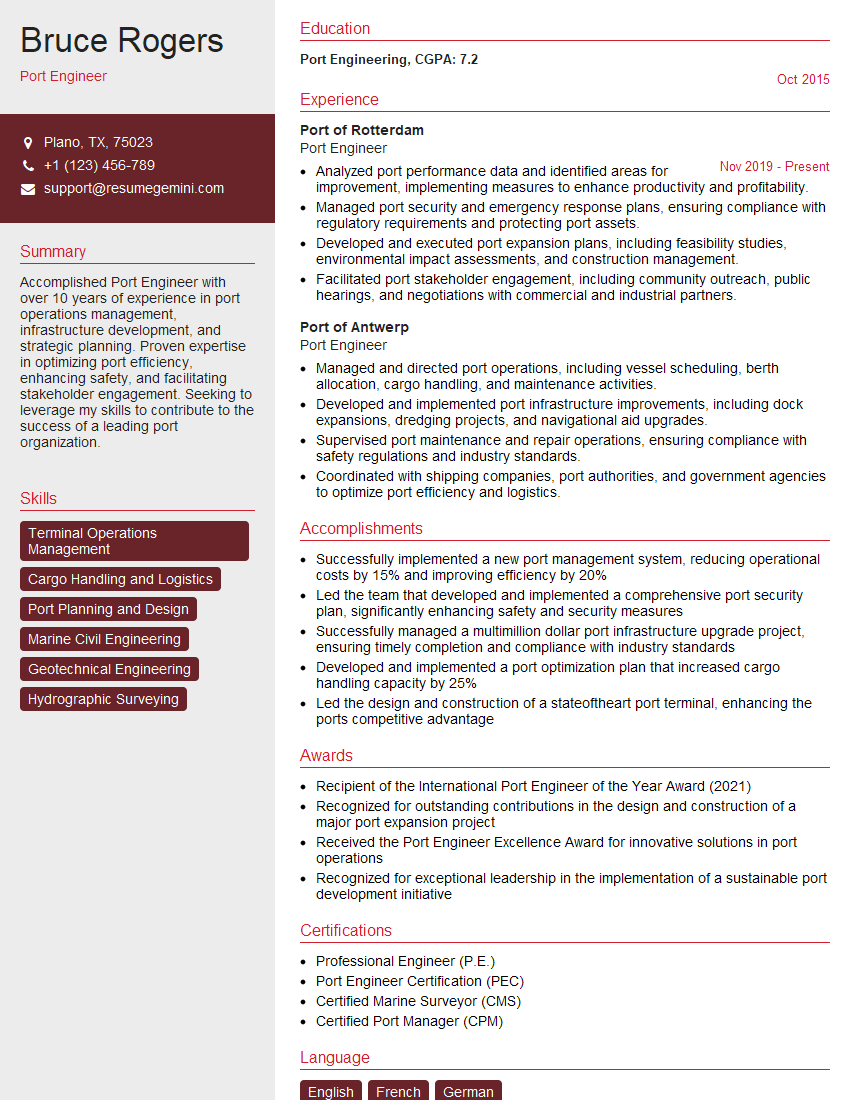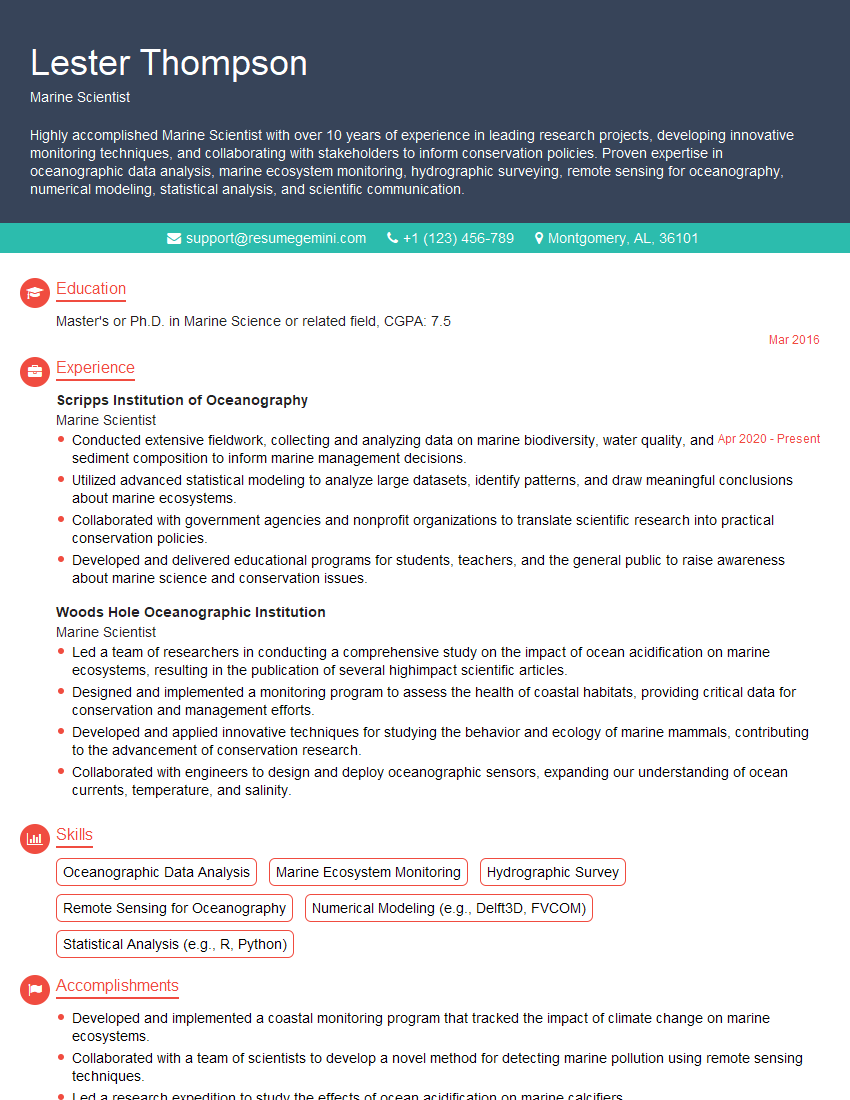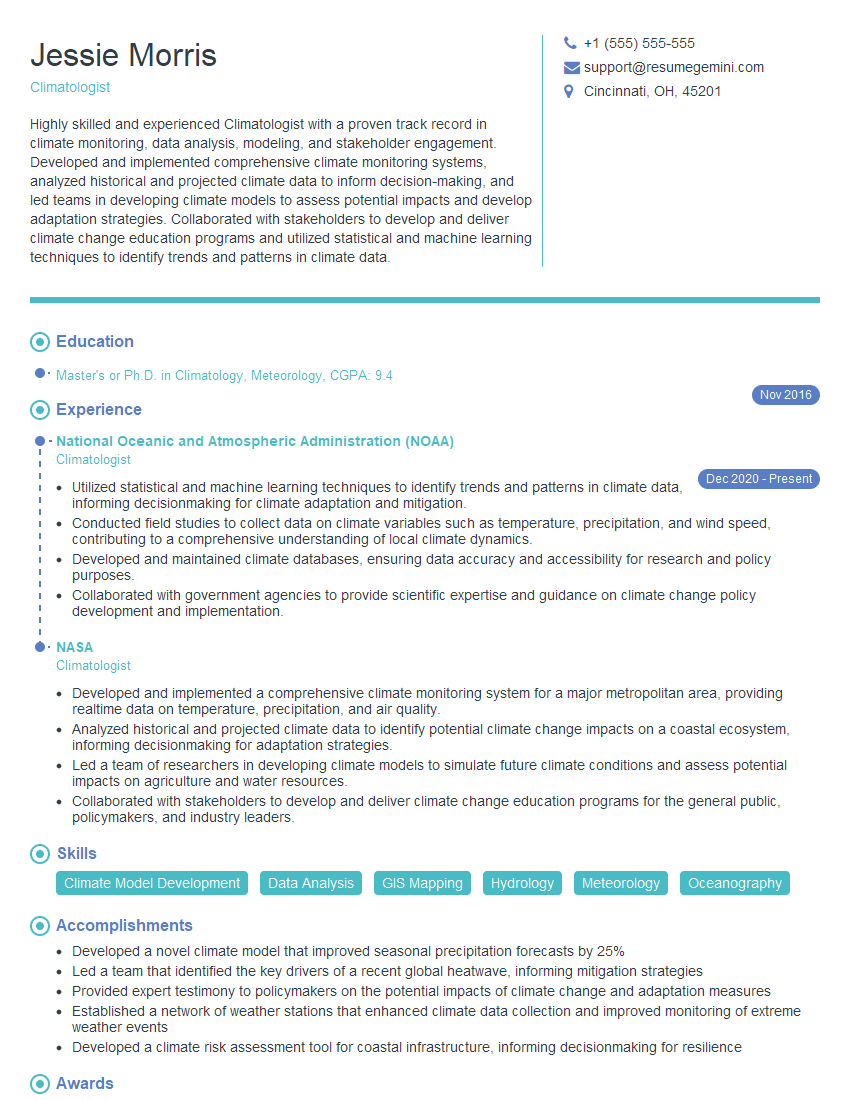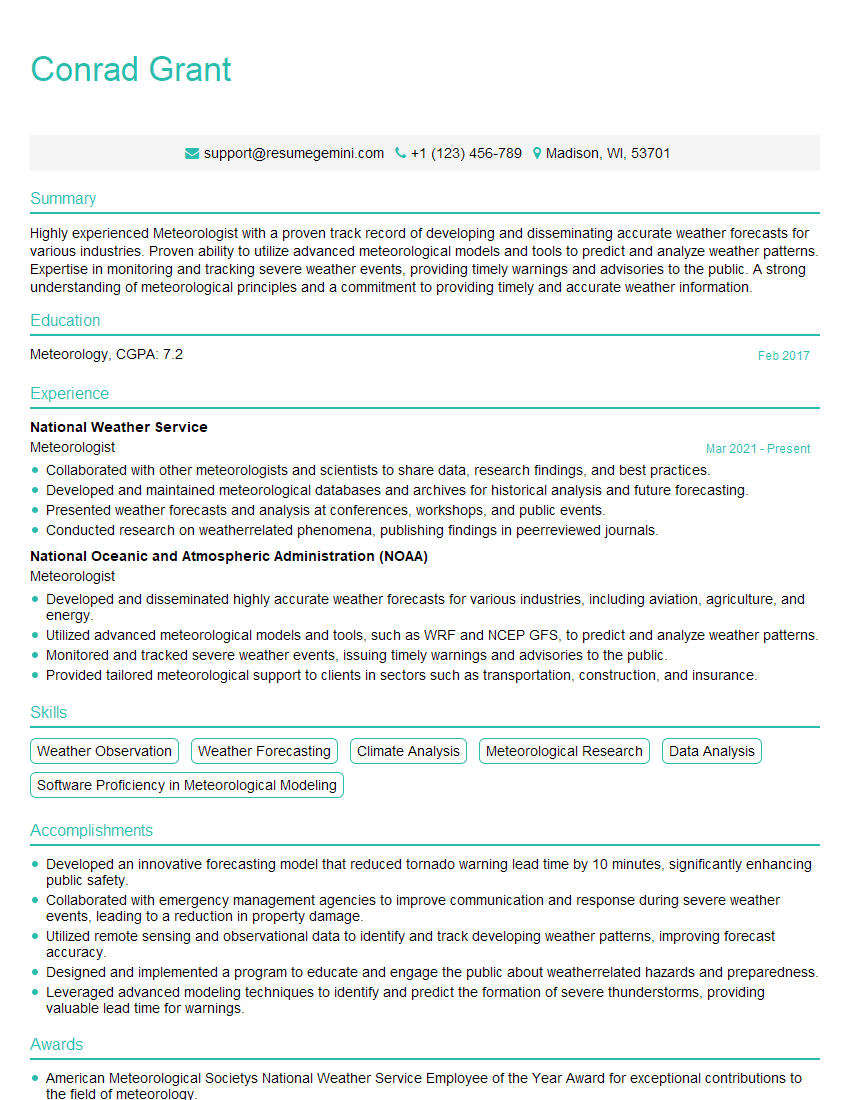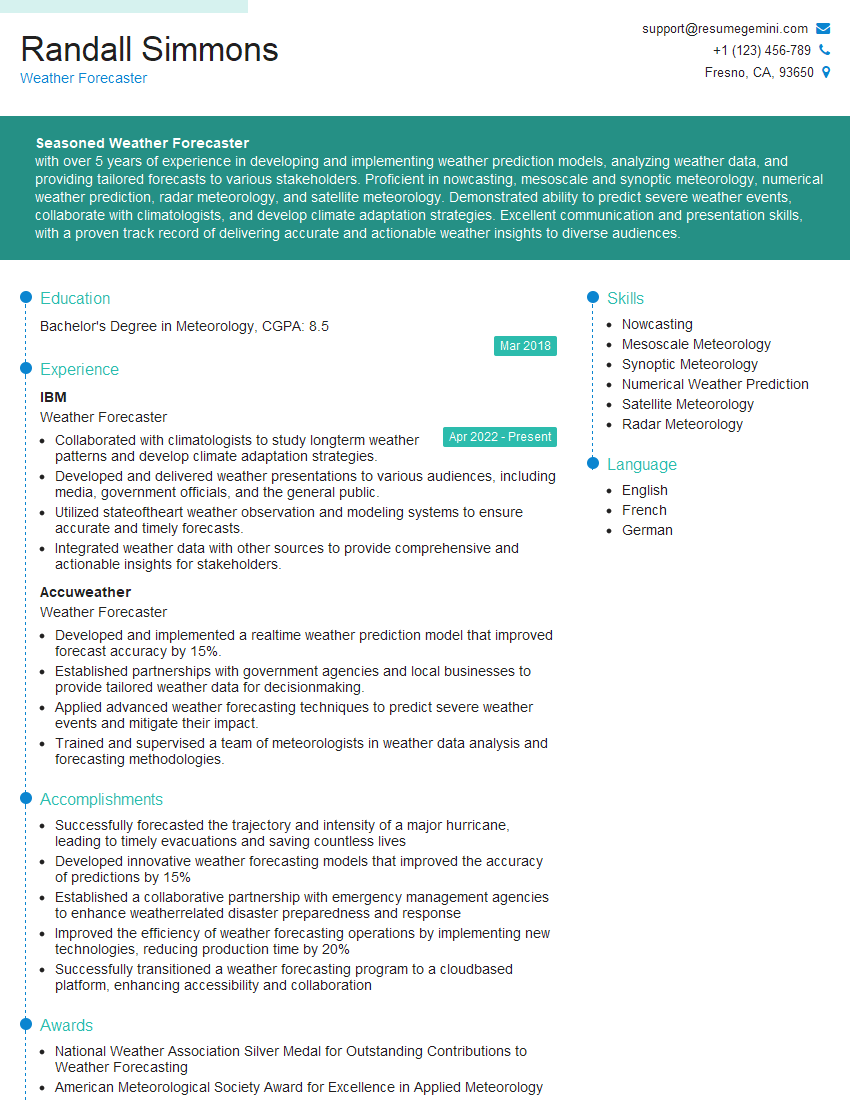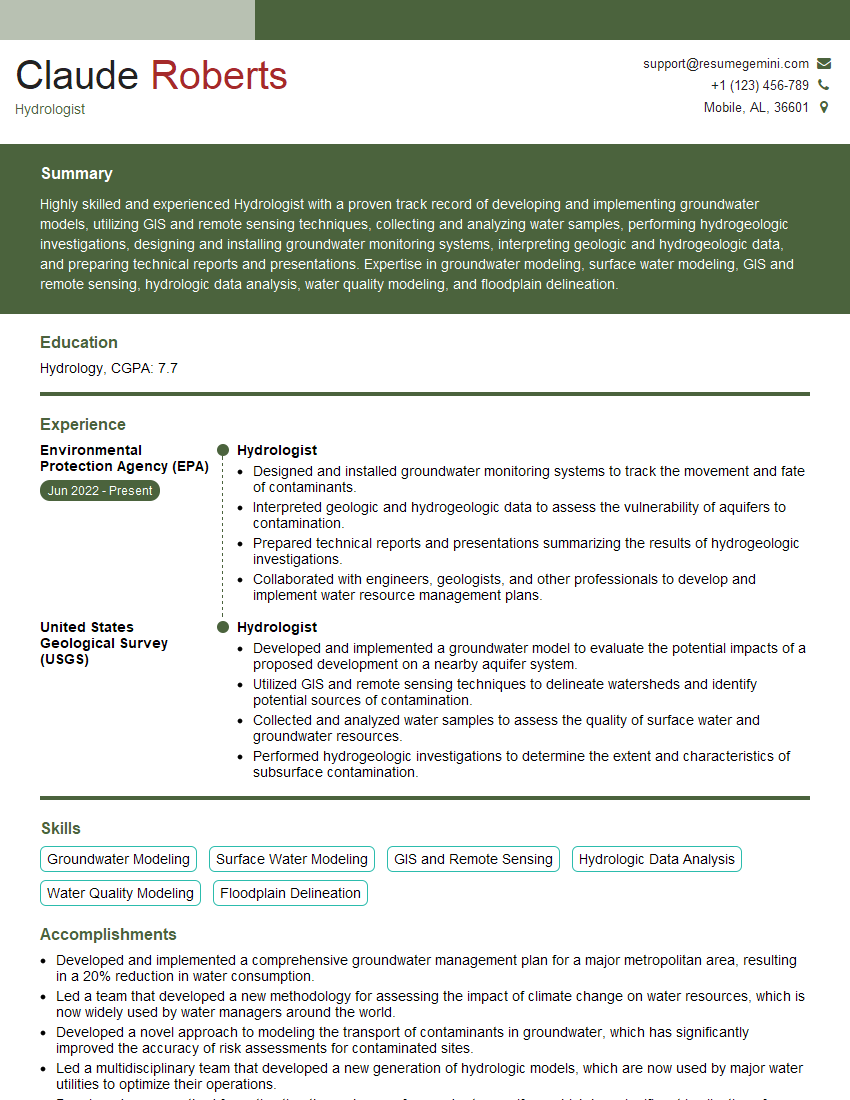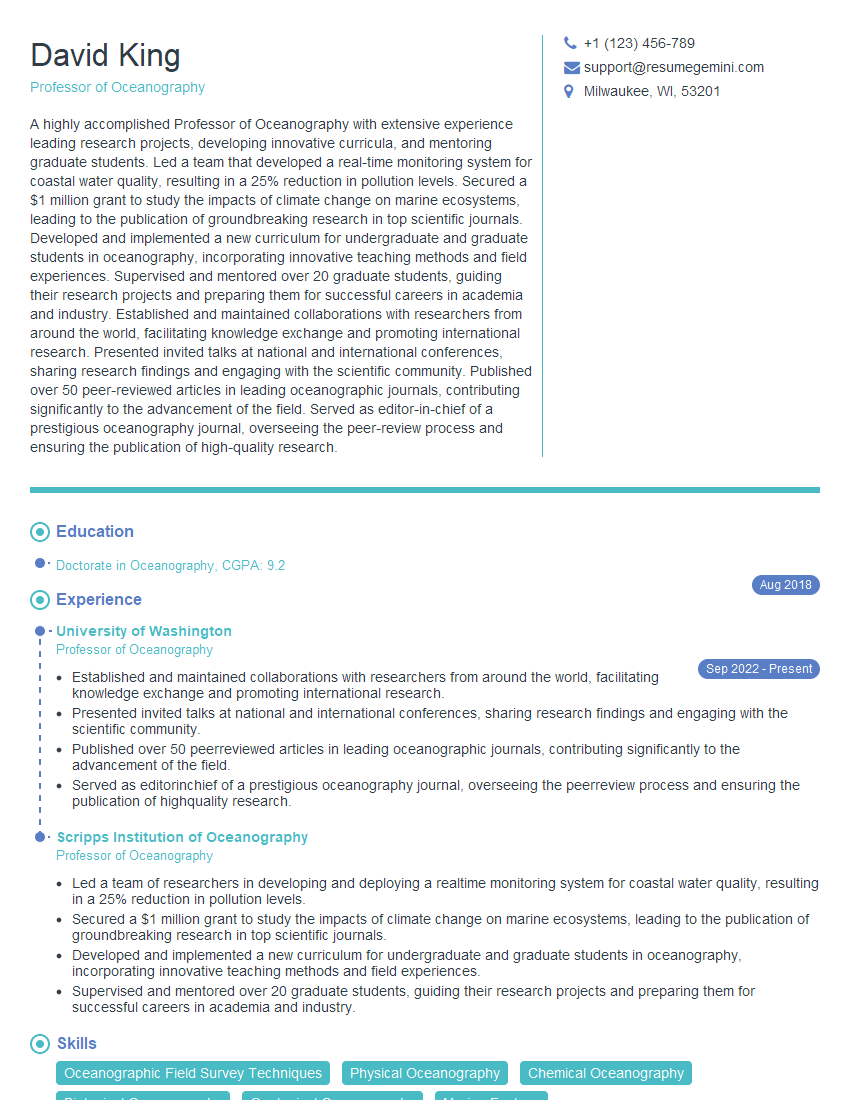The right preparation can turn an interview into an opportunity to showcase your expertise. This guide to Tide and Weather Analysis interview questions is your ultimate resource, providing key insights and tips to help you ace your responses and stand out as a top candidate.
Questions Asked in Tide and Weather Analysis Interview
Q 1. Explain the difference between high tide and low tide.
High tide and low tide represent the cyclical rise and fall of sea levels caused primarily by the gravitational pull of the moon and, to a lesser extent, the sun. High tide is the period when the water level reaches its highest point, while low tide is when it reaches its lowest point. Imagine a bathtub filling and emptying – the filling corresponds to the rising tide, and the emptying, to the falling tide. This regular fluctuation is a fundamental aspect of coastal dynamics, shaping coastlines, influencing marine life, and impacting human activities.
Q 2. Describe the factors that influence tidal patterns.
Several factors intricately influence tidal patterns. The most significant is the gravitational pull of the moon, creating a bulge of water on the side of the Earth facing the moon and a corresponding bulge on the opposite side due to inertia. The sun’s gravity also plays a role, albeit weaker than the moon’s. The Earth’s rotation influences the timing of high and low tides, creating a roughly semi-diurnal (twice-daily) pattern in many locations. The shape and depth of the ocean basin, the coastline’s geometry, and even the Earth’s rotation speed all influence the local characteristics of tides. For example, a narrow bay might amplify the tidal range, leading to much higher high tides and lower low tides than in the open ocean.
Q 3. How do you predict high and low tide times for a specific location?
Predicting high and low tide times requires a combination of astronomical calculations and empirical observations. Hydrographic offices and specialized software use sophisticated models that incorporate the positions of the sun and moon, the Earth’s rotation, and bathymetric data (ocean depth information) for a given location. These models generate tidal predictions typically presented as tables or graphs showing the predicted water level at specific times. For instance, a maritime navigation app or website will give precise predictions for a specific port or coastal area. These predictions are crucial for safe navigation, coastal engineering projects, and marine operations.
Q 4. What is the significance of tidal currents in coastal regions?
Tidal currents, the horizontal movement of water associated with the rising and falling tides, are incredibly significant in coastal regions. These currents can be strong, impacting navigation, influencing sediment transport and the distribution of nutrients and pollutants. They also shape estuarine ecosystems, creating unique habitats for various organisms. For example, strong tidal currents can scour channels, keeping them navigable, but they can also be dangerous for smaller boats. Understanding tidal current patterns is vital for safe navigation, managing coastal erosion, and protecting sensitive marine environments.
Q 5. Explain the concept of tidal range.
Tidal range refers to the vertical difference between consecutive high and low tide levels. It’s the height of the tide’s fluctuation. A large tidal range means a significant difference between high and low tide, while a small tidal range indicates a less pronounced difference. The tidal range varies depending on geographical location and astronomical factors. For instance, the Bay of Fundy, known for its extreme tides, has one of the largest tidal ranges in the world, while some areas may experience a barely noticeable tidal range. Understanding tidal range is important for coastal planning, marine infrastructure design, and predicting the impact of tidal flooding.
Q 6. What are spring tides and neap tides? Explain their causes.
Spring tides and neap tides represent the extremes of the tidal range. Spring tides occur when the sun, moon, and Earth are aligned (during new and full moons), resulting in a higher high tide and a lower low tide – a larger tidal range than average. The combined gravitational pull of the sun and moon amplifies the tidal effect. Neap tides, on the other hand, occur when the sun and moon are at right angles to each other (during the first and third quarter moons), leading to a smaller tidal range than average. The sun’s gravitational pull partially cancels out the moon’s, resulting in more moderate high and low tides. Fishermen often take note of spring and neap tides because they affect the accessibility of fishing grounds and the abundance of marine life.
Q 7. Describe different types of weather models and their applications.
Weather models are sophisticated computer programs that simulate atmospheric processes to predict future weather conditions. Several types exist, each with its own strengths and weaknesses:
- Numerical Weather Prediction (NWP) models: These are the most common type, solving complex mathematical equations representing atmospheric physics. They range from global models covering the entire planet to high-resolution regional models focusing on smaller areas. Global models provide a broad overview, while regional models give more detailed local forecasts.
- Statistical models: These models use historical weather data and statistical techniques to predict future weather patterns. They are often simpler than NWP models and are useful when detailed atmospheric physics isn’t crucial.
- Ensemble models: These combine outputs from multiple NWP models, providing a range of possible future scenarios and an estimate of forecast uncertainty. They improve forecast reliability by acknowledging the inherent limitations of individual models.
Applications of weather models are vast, including daily weather forecasting, climate change research, severe weather warnings, aviation planning, agricultural management, and more. The accuracy and resolution of these models constantly improve with increased computational power and more sophisticated scientific understanding.
Q 8. How do you interpret weather charts and maps?
Interpreting weather charts and maps involves understanding the symbology and data representation used to depict various atmospheric conditions. Think of them as a visual language. I start by looking at the overall pattern – are there large high-pressure systems, low-pressure systems, fronts? Then I examine specific details like temperature isotherms (lines of equal temperature), isobars (lines of equal pressure), wind vectors (showing wind speed and direction), and precipitation symbols. For example, a tightly packed group of isobars indicates a strong pressure gradient and therefore strong winds. A cold front, depicted by a line of blue triangles, signifies the leading edge of a cold air mass pushing into warmer air, often bringing significant weather changes like thunderstorms and gusty winds. I’d also check the forecast validity time – how long is the data accurate for? Finally, I cross-reference the chart information with other data sources, like satellite imagery, radar data, and ground observations to build a holistic picture.
For example, if I see a low-pressure system developing over the ocean with high humidity indicated on the chart, I’d anticipate a potential for heavy rainfall and even tropical cyclone development, especially if the surrounding sea surface temperature is warm. I would then consult satellite imagery to verify cloud cover and structure.
Q 9. Explain the concept of atmospheric pressure and its relation to weather.
Atmospheric pressure is the force exerted by the weight of the air above a given point. It’s measured in millibars (mb) or hectopascals (hPa). Imagine a column of air extending from the ground all the way to the edge of space – its weight presses down on everything below it. High pressure systems typically bring clear, calm weather because the air is sinking, suppressing cloud formation. Low-pressure systems, on the other hand, are associated with rising air, leading to cloud formation and often precipitation, potentially strong winds. The pressure difference between high and low-pressure areas drives wind, the stronger the difference, the stronger the wind. Think of it like water flowing downhill – air flows from areas of high pressure to areas of low pressure.
A classic example is a hurricane or typhoon. These intense storms are characterized by extremely low central pressure, causing strong inward winds spiralling towards the center. This pressure gradient force is a key driver of the storm’s intensity and destructive power.
Q 10. What are the major components of the Earth’s atmosphere?
The Earth’s atmosphere is a complex mixture of gases, primarily nitrogen (approximately 78%) and oxygen (approximately 21%). These are the most abundant components, crucial for life on Earth. However, other gases are present in smaller but still significant amounts. These include:
- Argon: A relatively inert gas making up about 1% of the atmosphere.
- Carbon Dioxide: A greenhouse gas, vital for plant life but also contributing to climate change. Its concentration has been rising significantly due to human activities.
- Water Vapor: Highly variable, depending on temperature and location. It plays a crucial role in weather processes such as cloud formation and precipitation.
- Trace Gases: Other gases like neon, helium, methane, and ozone are present in much smaller amounts but can still have significant impacts on the atmosphere and climate.
The composition of the atmosphere isn’t uniform; it varies with altitude. For example, the concentration of ozone is highest in the stratosphere, forming the ozone layer that protects us from harmful ultraviolet radiation.
Q 11. Describe the various types of precipitation and their formation.
Precipitation is any form of water that falls from the atmosphere to the Earth’s surface. The formation process begins with the condensation of water vapor in the atmosphere. This typically occurs when air rises and cools, reaching its dew point – the temperature at which the air becomes saturated and can no longer hold all its water vapor. Several types of precipitation exist:
- Rain: Liquid water droplets larger than 0.5 mm in diameter.
- Snow: Ice crystals that form when the temperature is below freezing throughout the atmosphere.
- Sleet: Raindrops that freeze into small ice pellets as they fall through a layer of sub-freezing air.
- Freezing Rain: Supercooled rain that freezes upon contact with a surface that is at or below freezing. This forms a glaze of ice.
- Hail: Layers of ice that build up as raindrops are repeatedly carried upward in strong updrafts within thunderstorms.
The type of precipitation that forms depends on the temperature profile of the atmosphere. For example, if the temperature is below freezing throughout the entire atmosphere, snow will form. If the temperature is above freezing near the surface but below freezing at higher altitudes, sleet or freezing rain can occur.
Q 12. How do you forecast weather using numerical weather prediction (NWP) models?
Numerical Weather Prediction (NWP) models are complex computer programs that use mathematical equations to simulate the atmosphere’s behavior. They take vast amounts of observational data – temperature, pressure, humidity, wind speed, etc. – as input. These data are fed into the model, which solves the equations to predict the future state of the atmosphere. The process involves several steps:
- Data Assimilation: Combining observational data with the model’s previous forecast to create an initial state of the atmosphere.
- Model Integration: Running the model forward in time, using the equations to predict the evolution of weather parameters.
- Post-processing: Interpreting the model output to create forecasts in a user-friendly format, such as maps and charts. This often includes statistical adjustments to refine the forecast accuracy.
Different NWP models exist, each with its strengths and weaknesses, depending on the resolution, the physics incorporated, and the data used. The output from multiple models is often compared and combined to improve the reliability of the forecast. This is called ensemble forecasting, producing a range of possible outcomes.
Q 13. Explain the concept of wind shear and its impact on weather systems.
Wind shear is a change in wind speed or direction over a relatively short distance. It can be vertical (change with height) or horizontal (change over a horizontal distance). Wind shear is a significant factor in weather systems because it can destabilize the atmosphere, causing turbulence. In aviation, it is a major safety concern, potentially causing dangerous flight conditions. For example, vertical wind shear can lead to sudden changes in altitude and speed. Imagine an airplane encountering strong downdrafts – the shear can lead to instability and potentially hazardous situations.
In severe thunderstorms, strong wind shear can help organize the storm, creating supercells with rotating updrafts that can produce tornadoes. The rotation is a result of the horizontal wind shear acting on the rising air within the thunderstorm. Without sufficient wind shear, the storm may not be able to sustain its intensity and rotational structure.
Q 14. What are the different types of clouds and what do they indicate?
Clouds are classified based on their altitude and shape, providing valuable clues about current and upcoming weather conditions. There are three main cloud groups based on altitude:
- High clouds (Cirrus, Cirrocumulus, Cirrostratus): These are typically thin, wispy clouds made of ice crystals, often forming in fair weather but can also precede an approaching warm front. Cirrus clouds are often feathery and wispy, while cirrostratus can sometimes create a halo around the sun or moon.
- Middle clouds (Altocumulus, Altostratus): These are usually grayish or whitish, often appearing as layered clouds or patchy formations. Altocumulus clouds can appear as small, rounded puffs while altostratus clouds are more sheet-like.
- Low clouds (Stratus, Stratocumulus, Nimbostratus): These are often associated with overcast conditions and precipitation. Stratus clouds are typically uniform, gray layers that can produce drizzle. Nimbostratus clouds are dark, thick layers that bring continuous rain or snow. Stratocumulus clouds are patchy layers with some breaks in the cloud cover.
In addition to these main groups, there are also clouds with significant vertical development, like cumulus and cumulonimbus. Cumulus clouds are fluffy, cotton-like clouds that form on sunny days due to convection (rising warm air). Cumulonimbus clouds are towering, dark clouds associated with thunderstorms, heavy rain, hail, and sometimes tornadoes.
Cloud observation is a crucial skill in weather forecasting, offering valuable insights into atmospheric stability, moisture content, and the likelihood of precipitation.
Q 15. Describe the different layers of the atmosphere and their characteristics.
The Earth’s atmosphere is layered, each layer possessing unique characteristics in terms of temperature, pressure, and composition. Think of it like an onion, with distinct layers.
- Troposphere: This is the lowest layer, where we live and weather occurs. Temperature generally decreases with altitude, and it contains most of the atmosphere’s mass and water vapor. Imagine it as the ‘weather layer’.
- Stratosphere: Above the troposphere, the stratosphere contains the ozone layer, which absorbs harmful ultraviolet radiation from the sun. Temperature increases with altitude in this layer due to ozone absorption.
- Mesosphere: Temperature decreases with altitude here, making it the coldest layer. Meteors burn up in this layer.
- Thermosphere: Temperature increases dramatically with altitude due to absorption of high-energy solar radiation. This is where the aurora borealis and aurora australis occur.
- Exosphere: The outermost layer, where the atmosphere gradually merges with space. The air is extremely thin here.
Understanding these layers is crucial for accurate weather forecasting, as weather phenomena are primarily confined to the troposphere, while processes in the stratosphere and above can influence long-term climate patterns.
Career Expert Tips:
- Ace those interviews! Prepare effectively by reviewing the Top 50 Most Common Interview Questions on ResumeGemini.
- Navigate your job search with confidence! Explore a wide range of Career Tips on ResumeGemini. Learn about common challenges and recommendations to overcome them.
- Craft the perfect resume! Master the Art of Resume Writing with ResumeGemini’s guide. Showcase your unique qualifications and achievements effectively.
- Don’t miss out on holiday savings! Build your dream resume with ResumeGemini’s ATS optimized templates.
Q 16. How do you interpret satellite imagery for weather forecasting?
Satellite imagery is invaluable for weather forecasting. Different wavelengths of light reveal different aspects of the atmosphere. For example:
- Visible imagery: Shows cloud cover, allowing us to track storm systems and fronts. Think of it as a picture taken from space.
- Infrared imagery: Detects temperature differences, helping us identify areas of rising and sinking air, essential for understanding storm development and intensity. Colder clouds are usually higher and indicative of stronger storms.
- Water vapor imagery: Reveals the distribution of moisture in the atmosphere, crucial for predicting precipitation and humidity.
By analyzing changes in these images over time, meteorologists can track the movement and evolution of weather systems, improving the accuracy of their forecasts. For example, a sudden increase in cloud top temperatures in an infrared image might signal the intensification of a hurricane.
Q 17. What are the limitations of weather forecasting?
Weather forecasting, while remarkably advanced, has inherent limitations. The atmosphere is a chaotic system, meaning small changes in initial conditions can lead to large variations in the outcome. This is commonly known as the ‘butterfly effect’.
- Data limitations: We don’t have perfect coverage of atmospheric conditions everywhere on Earth. Data sparsity in certain regions can impact forecast accuracy, especially in developing countries.
- Model limitations: Numerical weather prediction models are incredibly complex, but they are still simplifications of reality. Imperfect model physics and computational limitations introduce uncertainties.
- Chaotic nature of the atmosphere: The inherent unpredictability of the atmosphere places a natural limit on how far into the future we can reliably predict weather.
For instance, accurately predicting a thunderstorm’s exact location and time more than a few hours in advance remains challenging due to these limitations. This is why forecasts usually provide probabilities rather than certainties, especially for longer-range forecasts.
Q 18. Explain the Coriolis effect and its influence on weather patterns.
The Coriolis effect is an inertial force that appears to deflect moving objects (like air masses) to the right in the Northern Hemisphere and to the left in the Southern Hemisphere. It’s not a real force, but a consequence of the Earth’s rotation.
Imagine spinning a merry-go-round. If you throw a ball across it, it won’t travel in a straight line; it will appear to curve. The Coriolis effect is similar, but on a much larger scale. This deflection influences wind patterns, creating large-scale circulation systems like cyclones (low-pressure systems rotating counter-clockwise in the Northern Hemisphere) and anticyclones (high-pressure systems rotating clockwise in the Northern Hemisphere).
The effect is strongest at the poles and negligible at the equator. It plays a crucial role in shaping global weather patterns, influencing the formation and paths of storms, and impacting ocean currents.
Q 19. Describe the different types of weather fronts and their associated weather.
Weather fronts are boundaries between air masses of different temperatures and densities. These boundaries cause significant weather changes.
- Cold front: A cold air mass pushes into a warmer air mass, forcing the warm air to rise rapidly. This leads to the formation of cumulonimbus clouds, producing heavy showers, thunderstorms, and sometimes hail. Think of it as a fast-moving wedge of cold air.
- Warm front: A warm air mass advances over a cooler air mass. The warm air rises more gradually, leading to the formation of stratiform clouds, resulting in widespread light to moderate precipitation. Imagine a gentler, more widespread approach of warmer air.
- Occluded front: A complex front where a cold front catches up with a warm front, forcing the warm air aloft. Weather associated with occluded fronts is often a mixture of characteristics from both cold and warm fronts, depending on the type of occlusion.
- Stationary front: A boundary between two air masses that is not moving. This often results in prolonged periods of cloudiness and precipitation.
Understanding front movements is crucial for predicting short-term weather changes. Knowing the type of front approaching allows for targeted warnings and preparations for the associated weather impacts.
Q 20. How do you use meteorological instruments like barometers and anemometers?
Meteorological instruments are essential for gathering weather data. Here’s how some key instruments are used:
- Barometer: Measures atmospheric pressure. Falling pressure often indicates approaching low-pressure systems and stormy weather, while rising pressure usually signals fair weather. A barometer provides a valuable snapshot of atmospheric conditions.
- Anemometer: Measures wind speed. This is crucial for monitoring storm intensity and for various applications such as aviation and shipping. Knowing wind speed is vital for safety and forecasting.
- Thermometer: Measures temperature, a fundamental parameter for understanding weather conditions and forecasting. Extreme temperature fluctuations can also be indications of severe weather.
- Hygrometer: Measures humidity, indicating the amount of water vapor in the air. This is crucial for predicting precipitation and fog formation.
- Rain gauge: Measures rainfall accumulation. This helps meteorologists assess the intensity and duration of precipitation events, vital for flood warnings and water resource management.
Modern weather stations often incorporate automated sensors and data loggers that provide continuous measurements and transmit data to weather forecasting centers.
Q 21. Explain the concept of climate change and its impact on weather patterns.
Climate change refers to long-term changes in global temperature and weather patterns. It’s primarily caused by an increase in greenhouse gases (like carbon dioxide and methane) in the atmosphere due to human activities.
The impact on weather patterns is significant and multifaceted:
- Increased frequency and intensity of extreme weather events: Climate change is leading to more frequent and intense heatwaves, droughts, floods, hurricanes, and wildfires.
- Changes in precipitation patterns: Some regions experience increased rainfall and flooding, while others face prolonged droughts.
- Sea level rise: Melting glaciers and thermal expansion of seawater contribute to rising sea levels, increasing the risk of coastal flooding.
- Ocean acidification: The absorption of excess carbon dioxide by the oceans is making them more acidic, harming marine ecosystems.
Understanding these impacts is vital for developing strategies to mitigate the effects of climate change and adapt to a changing climate. For example, improvements to coastal defenses and drought-resistant crops are being developed to address these challenges. The data collected by meteorological instruments and satellites provides critical insights into these changes, allowing us to monitor their impact and refine our understanding of this crucial phenomenon.
Q 22. Describe the different types of ocean currents and their formation.
Ocean currents are large-scale movements of water in the ocean, driven by a combination of factors. They can be broadly categorized into several types:
- Surface Currents: Primarily driven by wind patterns, these currents are found in the upper layers of the ocean. The Coriolis effect (the apparent deflection of moving objects due to Earth’s rotation) significantly influences their direction, creating large, circular gyres in each ocean basin. The Gulf Stream, a powerful warm current flowing up the eastern coast of North America, is a prime example.
- Deep Ocean Currents (Thermohaline Circulation): These currents are driven by differences in water density, caused by variations in temperature (thermo) and salinity (haline). Cold, salty water is denser and sinks, creating a deep-water current that flows slowly across the ocean basins. This process is crucial for global heat distribution.
- Tidal Currents: These are caused by the gravitational pull of the moon and sun, creating a rhythmic flow of water into and out of coastal areas. They are predictable and vary in strength depending on the tidal range (the difference between high and low tide).
The formation of currents is a complex interplay of these forces. Wind pushes water at the surface, creating friction that extends to deeper layers. Density differences create pressure gradients that drive deep currents. The shape of the ocean floor and continental boundaries also influence current paths, guiding and diverting them.
Q 23. How do ocean currents affect weather patterns?
Ocean currents significantly influence weather patterns through their role in heat and moisture transport. Warm currents carry heat from the tropics towards the poles, moderating the climate of coastal regions. For example, the Gulf Stream keeps Western Europe much warmer than other regions at similar latitudes. Conversely, cold currents can cool coastal areas, creating drier, cooler climates.
Ocean currents also affect atmospheric circulation. The evaporation of water from warm currents adds moisture to the atmosphere, fueling storms and influencing rainfall patterns. El Niño, a climate pattern characterized by unusually warm ocean temperatures in the Pacific, is a dramatic example of how ocean currents can impact global weather. The changes in ocean temperature associated with El Niño disrupt atmospheric circulation patterns, leading to significant alterations in weather across the globe.
Q 24. Explain the concept of upwelling and its ecological significance.
Upwelling is a process where cold, nutrient-rich water from the deep ocean rises to the surface. This typically occurs along coastlines where winds blow parallel to the shore. The wind pushes surface water away from the coast, creating a void that is filled by the upwelling of deeper water.
Upwelling is ecologically significant because it brings vital nutrients like nitrates and phosphates to the surface. These nutrients fuel phytoplankton growth, forming the base of the marine food web. Areas with strong upwelling, like the coasts of Peru and California, are known for their high marine productivity and rich biodiversity, supporting vibrant fisheries.
Imagine a conveyor belt bringing up fresh nutrients from the depths – that’s essentially what upwelling does. It’s a crucial process for sustaining marine life and global ecosystems.
Q 25. How do you analyze tidal data using statistical methods?
Analyzing tidal data often involves using statistical methods to understand patterns and predict future tides. Common techniques include:
- Harmonic Analysis: This method decomposes complex tidal signals into a sum of simpler sinusoidal waves, each representing a different tidal constituent (e.g., lunar semi-diurnal, solar diurnal). This allows us to identify the dominant tidal components and predict future tides with reasonable accuracy.
- Time Series Analysis: Techniques like ARIMA (Autoregressive Integrated Moving Average) modeling can be applied to tidal data to identify trends, seasonality, and other patterns. This is particularly useful for forecasting tides and identifying long-term changes.
- Regression Analysis: This can be used to model the relationship between tidal heights and other variables, such as atmospheric pressure or river discharge. This helps to understand the influence of these factors on tidal behavior.
Software packages like MATLAB or R are commonly used for these analyses, providing tools for data manipulation, statistical modeling, and visualization. For example, fft() function in MATLAB can be used to perform harmonic analysis on time series tidal data.
Q 26. What software or tools are you familiar with for tide and weather analysis?
I’m proficient in several software and tools used for tide and weather analysis. These include:
- MATLAB: A powerful environment for numerical computation, data analysis, and visualization. It’s excellent for processing large datasets, performing statistical analyses, and developing custom algorithms.
- R: A versatile open-source statistical computing language with extensive libraries for time series analysis, spatial data analysis, and data visualization. Its flexibility makes it suitable for a broad range of tasks.
- Python with libraries like NumPy, Pandas, and SciPy: Python provides a robust framework for data manipulation, analysis, and modeling. These libraries offer specific tools for handling time series, performing statistical analyses, and creating visualizations.
- Specialized Hydrographic Software: Packages like TideGraph or other commercially available software provide tailored solutions for tidal analysis, including prediction, charting, and data management.
- NOAA and other meteorological agency datasets: I’m also familiar with accessing and working with large datasets from national meteorological and oceanographic agencies, which are vital for comprehensive analyses.
Q 27. Describe a time you had to solve a complex problem related to weather or tide data.
In a recent project, we needed to forecast storm surges accurately for a coastal region with a complex bathymetry (seabed topography) and significant river influence. Initial models significantly underestimated the surge heights, leading to concerns about potential flooding. We approached the problem systematically:
- Data Gathering: We compiled historical tidal data, meteorological data (wind speed, pressure), and river discharge data. We also obtained high-resolution bathymetric data using sonar surveys.
- Model Refinement: We realized that the initial models didn’t adequately account for the interaction between tides, river flow, and wind-driven setup (water piling up due to wind). We added these factors into our hydrodynamic model, using a more sophisticated numerical scheme.
- Calibration and Validation: We used historical storm surge events to calibrate and validate the improved model. This involved adjusting model parameters to best match the observed data. The calibration process improved our accuracy significantly.
- Prediction and Uncertainty Analysis: Once the model was validated, we used it to predict storm surge heights under different storm scenarios, including uncertainties in our data and model parameters.
This iterative process of data analysis, model refinement, and validation led to significantly more accurate storm surge forecasts, allowing for better emergency preparedness.
Q 28. How do you stay updated on the latest advancements in tide and weather analysis?
Staying updated in this rapidly evolving field requires a multi-faceted approach:
- Scientific Publications: I regularly read peer-reviewed journals like the Journal of Geophysical Research, Oceanography, and Coastal Engineering, focusing on articles concerning advances in data assimilation, numerical modeling, and statistical methods.
- Conferences and Workshops: Attending conferences like the Ocean Sciences Meeting or the American Meteorological Society meetings provides opportunities to learn about the latest research and network with other professionals in the field.
- Online Resources: I actively follow online resources like NOAA’s website, scientific blogs, and online repositories of data and code. This allows me to access the latest data sets and stay informed about new tools and techniques.
- Professional Networks: Membership in relevant professional organizations facilitates access to newsletters, webinars, and networking opportunities, keeping me abreast of new developments.
By actively pursuing these avenues, I ensure that my expertise remains current and that I can incorporate the latest advancements into my work.
Key Topics to Learn for Tide and Weather Analysis Interview
- Tidal Dynamics: Understanding tidal constituents, harmonic analysis, and predicting tidal heights and currents. Practical application: Analyzing tidal data to inform coastal engineering projects.
- Meteorological Data Analysis: Working with weather models (e.g., WRF, NWP), interpreting weather charts (surface analysis, upper air charts), and understanding atmospheric processes relevant to coastal regions. Practical application: Forecasting weather conditions to support maritime operations.
- Wave Analysis: Understanding wave generation, propagation, and transformation. Practical application: Assessing wave impact on coastal structures and navigation.
- Statistical Methods in Oceanography: Applying statistical techniques to analyze oceanographic data, including time series analysis and spatial statistics. Practical application: Identifying trends and patterns in tide and weather data.
- Data Visualization and Interpretation: Effectively communicating findings through charts, graphs, and maps. Practical application: Presenting analytical results to clients or stakeholders.
- Numerical Modeling: Experience with hydrodynamic and atmospheric models. Practical application: Simulating the combined effects of tides and weather on coastal systems.
- Oceanographic Instrumentation: Familiarity with common instruments used for measuring tides, waves, and meteorological parameters. Practical application: Understanding data quality and limitations.
Next Steps
Mastering Tide and Weather Analysis opens doors to exciting careers in coastal engineering, oceanography, maritime operations, and environmental consulting. To significantly boost your job prospects, it’s crucial to present your skills effectively. Creating an ATS-friendly resume is paramount for getting your application noticed. We strongly recommend using ResumeGemini to build a professional and impactful resume. ResumeGemini offers a streamlined process and provides examples of resumes tailored to Tide and Weather Analysis to help you showcase your expertise. Invest time in crafting a compelling resume – it’s your first impression on potential employers.
Explore more articles
Users Rating of Our Blogs
Share Your Experience
We value your feedback! Please rate our content and share your thoughts (optional).
What Readers Say About Our Blog
Hello,
We found issues with your domain’s email setup that may be sending your messages to spam or blocking them completely. InboxShield Mini shows you how to fix it in minutes — no tech skills required.
Scan your domain now for details: https://inboxshield-mini.com/
— Adam @ InboxShield Mini
Reply STOP to unsubscribe
Hi, are you owner of interviewgemini.com? What if I told you I could help you find extra time in your schedule, reconnect with leads you didn’t even realize you missed, and bring in more “I want to work with you” conversations, without increasing your ad spend or hiring a full-time employee?
All with a flexible, budget-friendly service that could easily pay for itself. Sounds good?
Would it be nice to jump on a quick 10-minute call so I can show you exactly how we make this work?
Best,
Hapei
Marketing Director
Hey, I know you’re the owner of interviewgemini.com. I’ll be quick.
Fundraising for your business is tough and time-consuming. We make it easier by guaranteeing two private investor meetings each month, for six months. No demos, no pitch events – just direct introductions to active investors matched to your startup.
If youR17;re raising, this could help you build real momentum. Want me to send more info?
Hi, I represent an SEO company that specialises in getting you AI citations and higher rankings on Google. I’d like to offer you a 100% free SEO audit for your website. Would you be interested?
Hi, I represent an SEO company that specialises in getting you AI citations and higher rankings on Google. I’d like to offer you a 100% free SEO audit for your website. Would you be interested?
good
